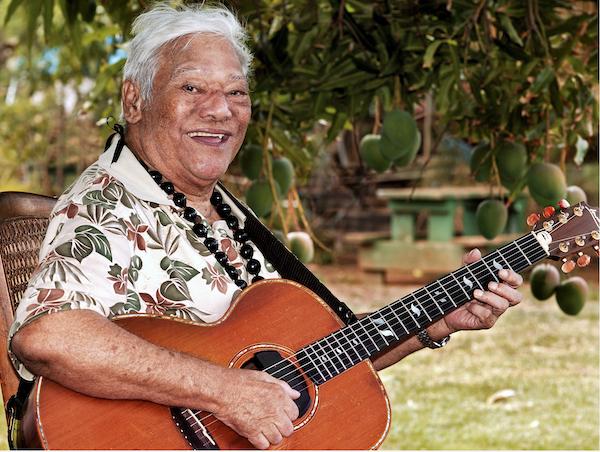Raymond Kane

Photo by Tom Pich
Bio
Raymond Kaleoalohapoinaoleohelemanu Kane was born October 2, 1925, in Eleéle on the island of Kauai in Hawaii, but grew up in Nanakuli, a district on the island of Oahu with a large ethnic Hawaiian population. His father captained a fishing crew, and growing up the young Kane was forever playing around the beach. It was a time, Kane said, when money was scarce: "People traded what they had for what they didn't ... vegetables for fish; fish for meat."
Around the age of nine, Kane learned to play the ki ho'alu, slack key guitar, from one of the cowboys on nearby Makua Ranch. "He brought his guitar down on weekends," Kane said. "They used to have a ball. They'd suck 'em up, have a good time. One time, I got up early in the morning and I heard this beautiful music. I thought there were three guys playing and it was only him. I asked him to teach me, and he said, 'No, no, no ... I can't because you're not in my family.' So, I told him, 'You get tired of eating mackerels,' and I gave him the names of some other fish that he liked. He said, 'Well, if you get those fish, I can teach you how to play the slack key guitar.'"
In slack key guitar, some strings are loosened, or slackened, to create open chords and to allow a musician to accompany his own melody line with a simultaneous bass line. Central to the particular sound of slack key is the use of these open tunings, whereby the six strings are changed from the classical guitar tuning to ones based upon open chords. This remarkable and creative style is traditionally passed on by imitation (without notation or scores); many of the tunings are standard, but others are kept secret — slack key guitarists often turn away from the audience to tune their instrument so that no one can copy them.
Kane learned quickly and began to entertain his friends and family when he wasn't working. During World War II, he served in the United States Army as part of the occupational forces in Europe. "I took my guitar everywhere I went," he said. "All my buddies wanted me to play for them. I put them to sleep."
After the war, Kane returned to Hawaii and began playing his distinctive slack key guitar at luaus, parties, and evenings on the beach. He worked with Albert Kawelo and Henry Kapuana from the island of Ni'ihau, the only island of the Hawaiian chain where ethnic Hawaiians are still the majority population and the Hawaiian language is dominant.
Kane jammed with Gabby "Pops" Pahinui at Wakiki nightspots and recorded an album in 1960 with Leonard Kwan. But it was not until 1973, when he gave the first-ever solo concert devoted entirely to slack key music, that Kane attained widespread public attention. "I don't know what you call my style," he said, "but I haven't met anyone who can play my style. My music is just straight, there's no break. The chord changes, you can't tell. It's smooth; one smooth movement." While Kane's left hand finds the chords he learned by watching others play, his right hand plucks casually along at the base of the guitar. Sometimes his left hand hammers at the strings, and sometimes the right one does.
In the 1980s, Kane's health deteriorated, but with the unrelenting support of his wife, Elodia, he found treatment that enabled him to perform again. In the 1990s, the couple toured together throughout Hawaii, Australia, Samoa, Tahiti, Guam, and elsewhere.
"I used to be bashful," Elodia said, "and didn't want to sing in public, but he kept coaxing me. 'Go ahead. Go ahead.'"

